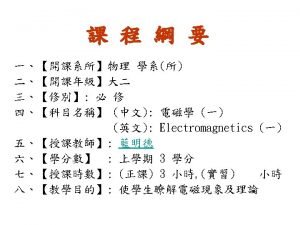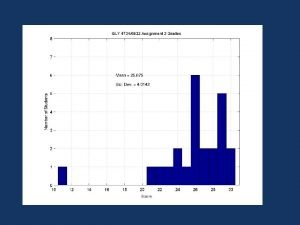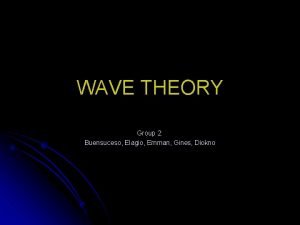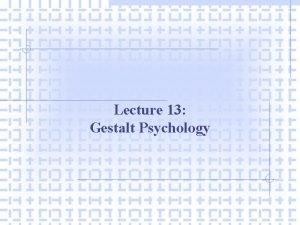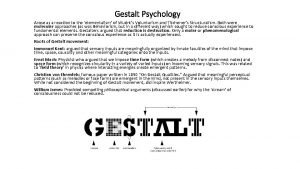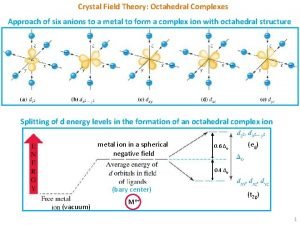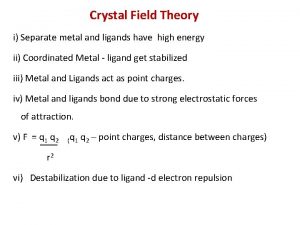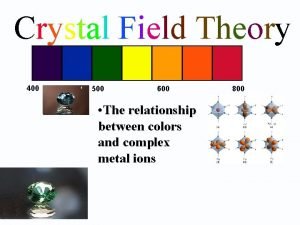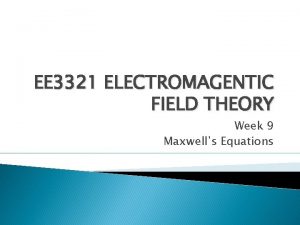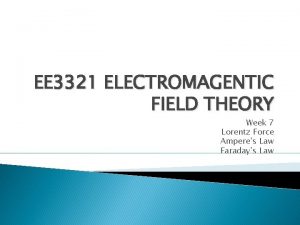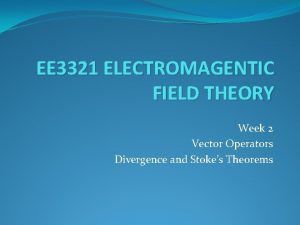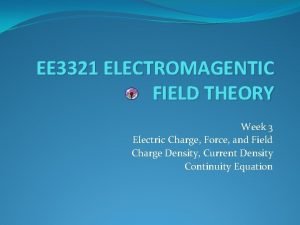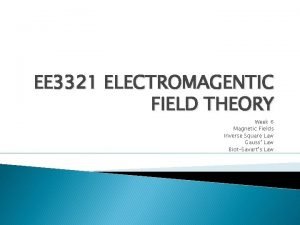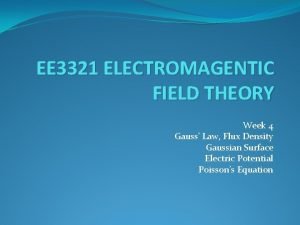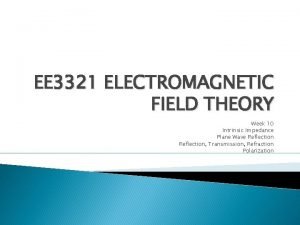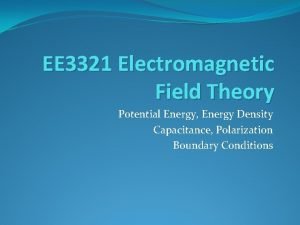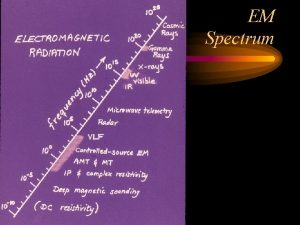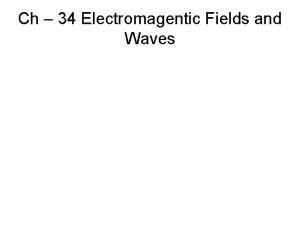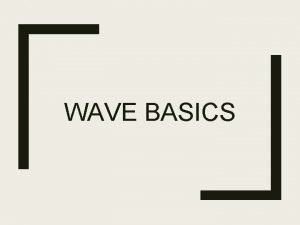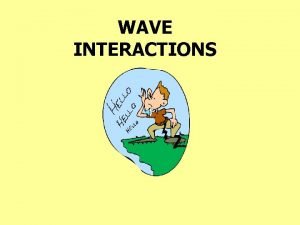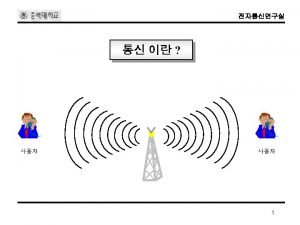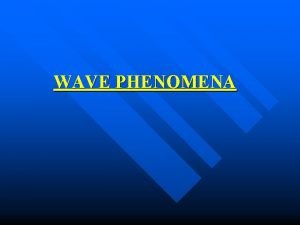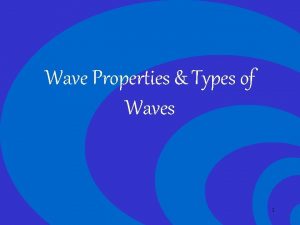EE 3321 ELECTROMAGENTIC FIELD THEORY Week 1 Wave


































- Slides: 34

EE 3321 ELECTROMAGENTIC FIELD THEORY Week 1 Wave Concepts Coordinate Systems and Vector Products

International System of Units (SI) �Length �Mass �Time �Current �Temperature meter kilogram second Ampere Kelvin m kg s A K �Newton = kg m/s 2 �Coulomb = A s � Volt = (Newton /Coulomb) m Dr. Benjamin C. Flores 2

Standard prefixes (SI) Symbol Factor 100 deca hecto kilo mega giga tera peta exa zetta yotta da h k M G T P E Z Y 101 102 103 106 109 1012 1015 1018 1021 1024 deci centi milli micro nano pico femto atto zepto yocto d c m µ n p f a z y 10− 1 10− 2 10− 3 10− 6 10− 9 10− 12 10− 15 10− 18 10− 21 10− 24 Symbol Factor 100 Dr. Benjamin C. Flores 3

Exercise �The speed of light in free space is c = 2. 998 x 105 km/s. Calculate the distance traveled by a photon in 1 ns. Dr. Benjamin C. Flores 4

Propagating EM wave �Characteristics �Amplitude �Phase � Angular frequency � Propagation constant �Direction of propagation �Polarization �Example �E(t, z) = Eo cos (ωt – βz) ax Dr. Benjamin C. Flores 5

Forward and backward waves �Sign Convention - βz propagation in +z direction + βz propagation in –z direction Which is it? a) forward traveling b) backward traveling Dr. Benjamin C. Flores 6

Partial reflection �This happens when there is a change in medium Dr. Benjamin C. Flores 7

Standing EM wave �Characteristics �Amplitude �Angular frequency �Phase �Polarization �No net propagation �Example �E(t, z) = A cos (ωt ) cos( βz) ax Dr. Benjamin C. Flores 8

Complex notation �Recall Euler’s formula exp(jφ) = cos (φ) + j sin (φ) Dr. Benjamin C. Flores 9

Exercise �Calculate the magnitude of exp(jφ) = cos (φ)+ j sin (φ) �Determine the complex conjugate of exp(j φ) Dr. Benjamin C. Flores 10

Traveling wave complex notation �Let φ = ωt – βz �Complex field Ec(t, z) = A exp [j(ωt – βz)] ax = A cos(ωt – βz) ax + j A sin(ωt – βz) ax E(z, t) = Real { Ec(t, z) } Dr. Benjamin C. Flores 11

Standing wave complex notation �E = A exp[ j(ωt – βz) + A exp[ j(ωt + βz) = A exp(jωt) [exp(–jβz) + exp(+jβz)] = 2 A exp(jωt) cos(βz) �E = 2 A[cos(ωt) + j sin (ωt) ] cos(βz) �Re { E } = 2 A cos(ωt) cos(βz) �Im { E } = 2 A sin(ωt) cos(βz) Dr. Benjamin C. Flores 12

Exercise Show that E(t) = A exp(jωt) sin(βz) can be written as the sum of two complex traveling waves. Hint: Recall that j 2 sin(φ) = exp (j φ) – exp(– j φ) Dr. Benjamin C. Flores 13

Transmission line/coaxial cable � Voltage wave �V = Vo cos (ωt – βz) �Current wave �I = Io cos (ωt – βz) � Characteristic Impedance �ZC = Vo / Io �Typical values: 50, 75 ohms Dr. Benjamin C. Flores 14

RADAR �Radio detection and ranging Dr. Benjamin C. Flores 15

Time delay �Let r be the range to a target in meters � φ = ωt – βr = ω[ t – (β/ω)r ] �Define the phase velocity as v = β/ω �Let τ = r/v be the time delay �Then φ = ω (t – τ) �And the field at the target is Ec(t, τ) = A exp [jω( t – τ )] ax Dr. Benjamin C. Flores 16

Definition of coordinate system �A coordinate system is a system for assigning real numbers (scalars) to each point in a 3 -dimensional Euclidean space. �Systems commonly used in this course include: �Cartesian coordinate system with coordinates x (length), y (width), and z (height) �Cylindrical coordinate system with coordinates ρ (radius on x-y plane), φ (azimuth angle), and z (height) �Spherical coordinate system with coordinates r (radius or range), Ф (azimuth angle), and θ (zenith or elevation angle) Dr. Benjamin C. Flores 17

Definition of vector �A vector (sometimes called a geometric or spatial vector) is a geometric object that has a magnitude, direction and sense. Dr. Benjamin C. Flores 18

Direction of a vector �A vector in or out of a plane (like the white board) are represented graphically as follows: �Vectors are described as a sum of scaled basis vectors (components): Dr. Benjamin C. Flores 19

Cartesian coordinates Dr. Benjamin C. Flores 20

Principal planes Dr. Benjamin C. Flores 21

Unit vectors �ax = i �ay = j �az = k �u = A/|A| Dr. Benjamin C. Flores 22

Handedness of coordinate system Left handed Right handed Dr. Benjamin C. Flores 23

Are you smarter than a 5 th grader? �Euclidean geometry studies the relationships among distances and angles in flat planes and flat space. �true �false �Analytic geometry uses the principles of algebra. �true �false Dr. Benjamin C. Flores 24

Cylindrical coordinate system Φ = tan-1 y/x ρ2 = x 2 + y 2 Dr. Benjamin C. Flores 25

Vectors in cylindrical coordinates �Any vector in Cartesian can be written in terms of the unit vectors in cylindrical coordinates: �The cylindrical unit vectors are related to the Cartesian unit vectors by: Dr. Benjamin C. Flores 26

Spherical coordinate system Φ = tan-1 y/x θ = tan-1 z/[x 2 + y 2]1/2 r 2 = x 2 + y 2 + z 2 Dr. Benjamin C. Flores 27

Vectors in spherical coordinates �Any vector field in Cartesian coordinates can be written in terms of the unit vectors in spherical coordinates: �The spherical unit vectors are related to the Cartesian unit vectors by: Dr. Benjamin C. Flores 28

Dot product �The dot product (or scalar product) of vectors a and b is defined as �a · b = |a| |b| cos θ where �|a| and |b| denote the length of a and b �θ is the angle between them. Dr. Benjamin C. Flores 29

Exercise �Let a = 2 x + 5 y + z and b = 3 x – 4 y + 2 z. �Find the dot product of these two vectors. �Determine the angle between the two vectors. Dr. Benjamin C. Flores 30

Cross product �The cross product (or vector product) of vectors a and b is defined as a x b = |a| |b| sin θ n where �θ is the measure of the smaller angle between a and b (0° ≤ θ ≤ 180°), �a and b are the magnitudes of vectors a and b, �and n is a unit vector perpendicular to the plane containing a and b. Dr. Benjamin C. Flores 31

Cross product Dr. Benjamin C. Flores 32

Exercise �Consider the two vectors a= 3 x + 5 y + 7 z and b = 2 x – 2 y – 2 z �Determine the cross product c = a x b �Find the unit vector n of c Dr. Benjamin C. Flores 33

Homework �Read all of Chapter 1, sections 1 -1, 1 -2, 1 -3, 1 -4, 1 -5, 1 -6 �Read Chapter 3, sections 3 -1, 3 -2, 3 -3 �Solve end-of-chapter problems 3. 1, 3. 3, 3. 5 , 3. 7, 3. 19, 3. 21, 3. 25, 3. 29 Dr. Benjamin C. Flores 34
 Dalga spektrumu
Dalga spektrumu Week by week plans for documenting children's development
Week by week plans for documenting children's development Sound waves are electromagnetic waves true or false
Sound waves are electromagnetic waves true or false Short wave vs long wave radiation
Short wave vs long wave radiation Difference between full wave and half wave rectifier
Difference between full wave and half wave rectifier Longitudinal vs transverse waves
Longitudinal vs transverse waves Half wave rectifier meaning
Half wave rectifier meaning Full wave rectifier vs bridge rectifier
Full wave rectifier vs bridge rectifier Earthquake p wave and swave travel time
Earthquake p wave and swave travel time Full wave rectified sine wave fourier series
Full wave rectified sine wave fourier series What is a wave
What is a wave The nature of waves chapter 10 section 1
The nature of waves chapter 10 section 1 Quarter wave symmetry
Quarter wave symmetry Electromagnetic and mechanical waves
Electromagnetic and mechanical waves Mechanical and electromagnetic waves similarities
Mechanical and electromagnetic waves similarities Transverse wave and longitudinal wave example
Transverse wave and longitudinal wave example Cheng field and wave electromagnetics
Cheng field and wave electromagnetics Gauss law in magnetism
Gauss law in magnetism Individual differences in second language learning
Individual differences in second language learning Field dependent vs field independent
Field dependent vs field independent Distinguish between magnetic and nonmagnetic materials
Distinguish between magnetic and nonmagnetic materials E field h field
E field h field Database field types and field properties
Database field types and field properties Field dependent and field independent
Field dependent and field independent Difference between electric field and magnetic field
Difference between electric field and magnetic field Airy wave theory
Airy wave theory Wave theory of light
Wave theory of light Groundhog day 2021
Groundhog day 2021 Pada kompleks oktahedral tingkat energi orbital
Pada kompleks oktahedral tingkat energi orbital Forces for change
Forces for change Gestaltistas
Gestaltistas Field theory psychology
Field theory psychology δo
δo Crystal field theory
Crystal field theory Spectrochemical series
Spectrochemical series
















